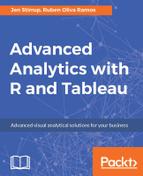Having understood how to integrate both the platforms in the previous chapter, we'll walk through the different ways in which you can use R to combine and compare data for analysis.
We will cover, with examples, the core essentials of R programming such as variables and data structures in R such as matrices, factors, vectors, and data frames. We will also focus on control mechanisms in R (relational operators, logical operators, conditional statements, loops, functions, and apply) and how to execute these commands in R to get grips with it before proceeding to chapters that heavily rely on these concepts for scripting complex analytical operations.
One of the reasons for R's success is its use of variables. Variables are used in all aspects of R programming. For example, variables can hold data, strings to access a database, whole models, queries, and test results. Variables are a key part of the modeling process, and their selection has a fundamental impact on the usefulness of the models. Therefore, variables are an important place to start since they are at the heart of R programming.
In the following section we will deal with the variables—how to create variables and working with variables.
It is very simple to create variables in R, and to save values in them. To create a variable, you simply need to give the variable a name, and assign a value to it.
In many other languages, such as SQL, it's necessary to specify the type of value that the variable will hold. So, for example, if the variable is designed to hold an integer or a string, then this is specified at the point at which the variable is created.
Unlike other programming languages, such as SQL, R does not require that you specify the type of the variable before it is created. Instead, R works out the type for itself, by looking at the data that is assigned to the variable.
In R, we assign variables using an assignment variable, which is a less than sign (<) followed by a hyphen (-). Put together, the assignment variable looks like so:
It is important to understand what is contained in the variables. It is easy to check the content of the variables using the ls command. If you need more details of the variables, then the ls.str command will provide you with more information.
If you need to remove variables, then you can use the rm function.
